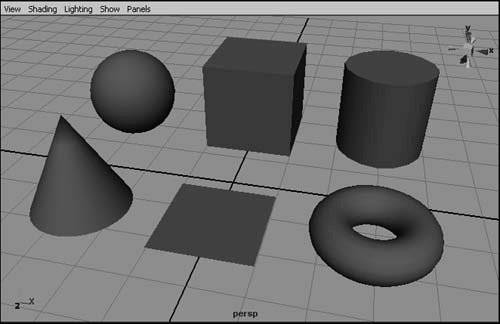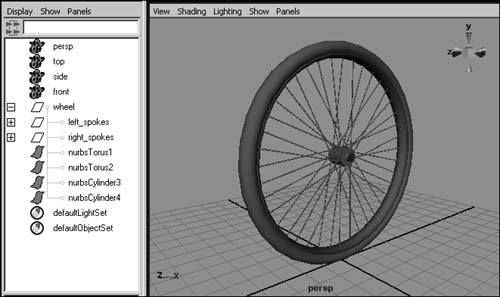Chapter 3. Creating Primitives and Text
| Primitives are pre-made geometry sets, usually in simple shapes: spheres, cubes, cylinders, planes, cones, and toruses (Figure 3.1). New in Maya 7.0, you can also create more unusual polygon primitives: prisms, pyramids, pipes, helixes, soccer balls, and platonic solids (Figure 3.2). Figure 3.1. The basic primitives (clockwise, from top left): sphere, cube, cylinder, torus, plane, cone. Figure 3.2. Maya 7.0's new polygon primitives (clockwise, from top left): prism, pyramid, pipe, platonic solid, soccer ball, helix. Primitives are the building blocks of 3D modeling, simplifying the creation of more complex objects. Some real-world objects can be constructed out of a single primitive shape: a baseball is a sphere, an unopened book is a scaled cube, and a box of doughnuts is a box of toruses. Other objects combine a number of different primitives. For example, a bicycle wheel combines thin cylinders for the spokes and hub with toruses for the rim and tire (Figure 3.3). Figure 3.3. This bicycle wheel is made from cylinder and torus primitives. Not everything is made out of primitives, but Maya's modeling tools allow you to modify primitives so extensively that you can make nearly any shape by starting with primitives. This makes them valuable time savers for almost any modeling task. If your scene needs text, you can also save time by using Maya's text tool, which automatically generates geometry for the text you enter. Maya's construction history feature allows you to change the attributes of primitives and other objects after you've created them. You can also rename them to make management of your scene simpler. |
EAN: 2147483647
Pages: 185